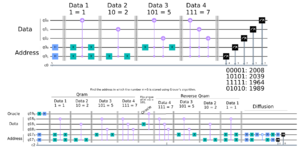QRAM: Difference between revisions
(→Theory) |
(→Theory) |
||
| (2 intermediate revisions by the same user not shown) | |||
| Line 6: | Line 6: | ||
The direct implementation of classical binary tree (using transistors) is rather impractical, as the exponential number of transistors is needed. | The direct implementation of classical binary tree (using transistors) is rather impractical, as the exponential number of transistors is needed. | ||
At least three different methods: Quantum Bus, Fanout and Bucket Brigade implementations. | |||
[[File:Qram.png|thumb]] | [[File:Qram.png|thumb]] | ||
| Line 28: | Line 30: | ||
https://github.com/qsharp-community/qram Nice animation. | https://github.com/qsharp-community/qram Nice animation. | ||
https://www.cs.umd.edu/class/fall2019/cmsc657/projects/group_11.pdf | |||
Latest revision as of 19:45, 29 November 2020
Introduction
Theory

The direct implementation of classical binary tree (using transistors) is rather impractical, as the exponential number of transistors is needed.
At least three different methods: Quantum Bus, Fanout and Bucket Brigade implementations.

The address and output registers of QRAM are composed of qubits instead of bits, though the memory array can be either quantum or classical.
Address register : superposition .
Data register with being the content of th memory cell. QRAM is the operation .
Example
Store the data array into a Qram addresses . Address register is .
References
https://arxiv.org/pdf/0708.1879.pdf
https://arxiv.org/pdf/2006.11761.pdf
https://github.com/qsharp-community/qram Nice animation.
https://www.cs.umd.edu/class/fall2019/cmsc657/projects/group_11.pdf






![{\displaystyle [1,2,5,7]=[1,10,101,111]_{2}}](https://wikimedia.org/api/rest_v1/media/math/render/svg/5c8de86f1d11d6e884dbdd21ea017468c302a28b)
![{\displaystyle [0,1]}](https://wikimedia.org/api/rest_v1/media/math/render/svg/738f7d23bb2d9642bab520020873cccbef49768d)
